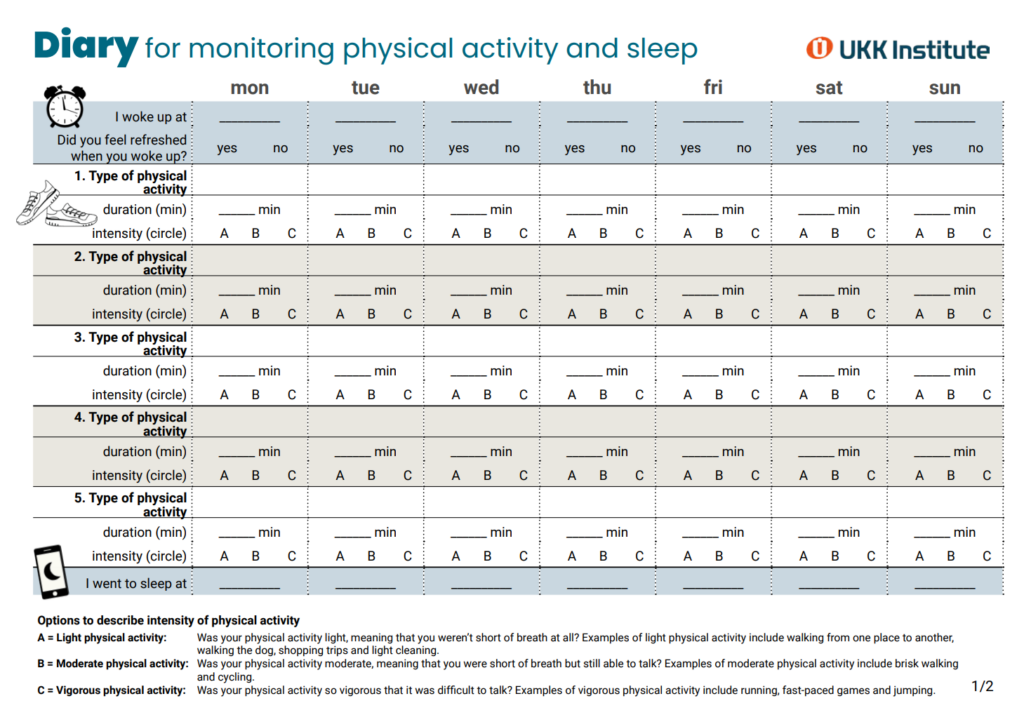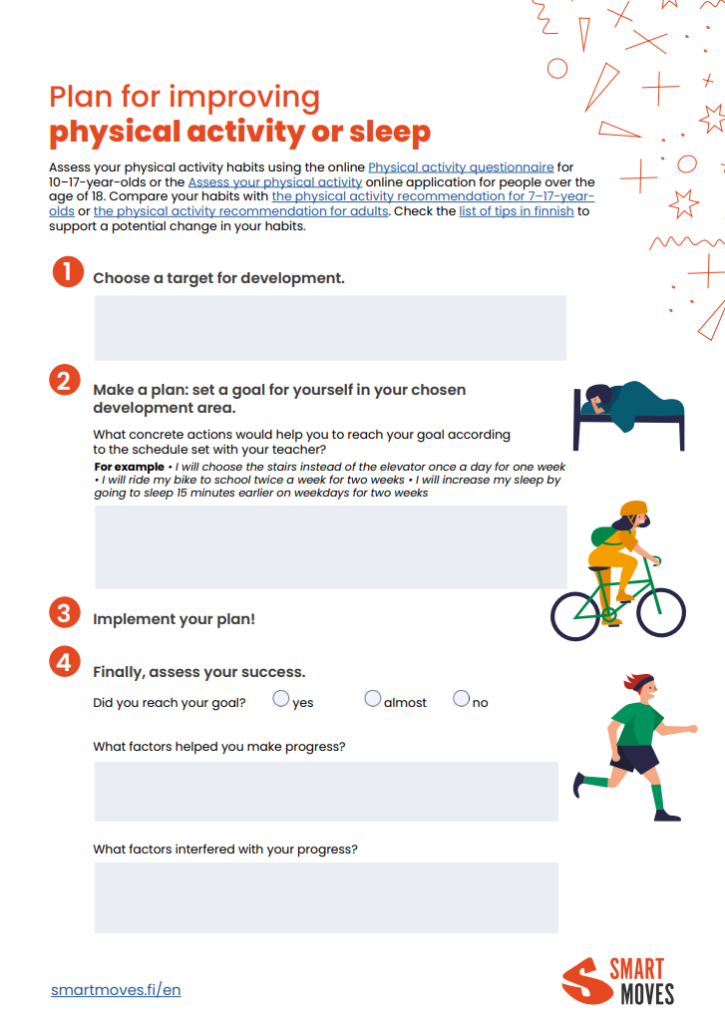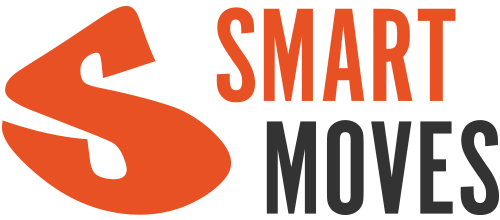Sisältö
This page provides you a physical activity lesson plan and related materials for upper secondary education. The two-lesson teaching unit is suitable for health education in general upper secondary school or the maintaining ability to work and well-being at work area of a vocational upper secondary qualification.
Lesson plan
Objectives
The student can identify the factors affecting their physical activity and sleep and is able to assess their significance in terms of your health. The student can provide justified suggestions about how to maintain health-promoting lifestyles and prevent those that endanger health.
The student can prepare a diverse plan to promote their own health and well-being, taking into consideration the importance of physical activity, recovery and sleep in terms of maintaining the ability to study and work. The student can realistically assess implementation of the plan and achievement of the goals.
Contents
The study module contains physical activity teaching content and a sleep-related reflection section. The plan also includes ideas for utilising teaching technology and suggestions for additional lessons.
Select the most important topics in terms of managing time use and adapt the lessons in the way you consider best.
Tools
The students need a computer, tablet or at least a smart phone and internet connection. For the second lesson, the students also need to fill in a diary in advance concerning their amount of physical activity and sleep during a one-week period. The diary template for monitoring physical activity and sleep is available as a print-out or an electronic version.
Other notes
It’s a good idea to fill in the diary close to the date of the second lesson. The students can also fill in the questionnaire based on their memory. If the previous week was unusual for some reason, such as illness, this should be taken into consideration when interpreting the diary. You can instruct the student to fill in the questionnaire again later during an ordinary week.
Lesson 1 (75 min.)
- Lesson 1 topics:
- Physical activity
- The benefits of physical activity
- Sedentary behaviour
- Physical activity recommendation
- Assignment 1. Ask the students to discuss the following questions in pairs or small groups:
- What is physical activity? (joint word cloud in the Mentimeter application)
- What kind of physical activity do you enjoy?
- Information content 1. Review what the concept “physical activity” means (slide 6). You can combine the answers on a board or in Mentimeter and start by reviewing what the students think physical activity means.
- Orientation: Watch the Smart Moves video “All physical activity is a positive step!”, in which secondary students reflect on the benefits of physical activity.
- Assignment 2. A reflection assignment, either independently or in pairs:
- What could physical activity do for you?
- Functional teaching idea: Play bingo on a 3×3 grid, where the students write something that physical activity could do for them in every square. Then the students try to find others who have written the same type of things on their bingo grid.
- Physical activity can inspire a lot of different feelings. On the other hand, physical activity can be a way of dealing with emotions. This section provides an opportunity to discuss physical activity and emotions with the students. You can add a functional element by asking the students to place themselves on an arc according to their opinion. For example, do certain activity situations inspire positive or negative feelings. Another option is to present emotions using pantomime.
- Helpful questions:
- What emotions have you felt in different physical activity situations?
- What caused that feeling?
- Are there any physical activity situations in which you have trouble controlling your emotions?
- Why is it sometimes good to control your emotions?
- How do the emotions affect behaviour in physical activity situations?
- How does physical activity help you deal with emotions?
- How are disappointments and physical activity linked to each other?
- Assignment 3. Write down the benefits of physical activity on, for example, a Padlet wall.
- Information content 2. Use the Padlet wall to review the benefits of physical activity under the teacher’s direction.
- Assignment 4. Ask the students to discuss the following questions in pairs or small groups. After the discussion, you can collect the answers in, for example, Mentimeter or Padlet. The students can also answer the questions directly into Mentimeter without the pair discussion.
- How do long periods of sitting or other sedentary behaviour affect your body and mind? How do you feel afterwards? (Mentimeter, Padlet)
- Studies show that students sit for an average of 9–10 hours per day. How much time do you think you spend sitting?
- Information content 3. Review how sedentary behaviour can affect health (slides 19–20).
- Assignment 5. Plan your own exercise breaks or try an exercise break from a video (slide 21).
- Information content 4. Animated video of the physical activity recommendation for children and adolescents: Show the students the two-minute animation about the key themes of the physical activity recommendation.
- Orientation: An active quiz about the physical activity recommendation (the quiz is on slides 23–33). Now the students answer questions about what makes up the physical activity recommendation.
- Information content 5. Review the physical activity recommendation (slide 34). You can also use the prepared presentation material on physical activity recommendations.
- Assignment 6. Ask the students to work in pairs and find the difference between light, moderate and vigorous physical activity (slide 35).
- Answer:
- Light (1.5–2.9 MET), moderate (3.0–5.9 MET) and vigorous (≥ 6.0 MET) physical activity
- One MET (metabolic equivalent of task) corresponds to the energy your body spends at rest. For example, the MET value when standing is 2, which means that the body consumes two times more oxygen and energy than when at rest.
- MET values are presented in the MET value table
- Answer:
- Information content 7. Review the concepts of physical activity to improve endurance and strengthen muscles and bones.
- Information content 8 and Assignment 7. Research data on the physical activity of adolescents and a reflection assignment (slide 38).
- What are the reasons for physical activity or lack of physical activity?
- Assignment 8. Instruct the students to keep a diary about their physical activity and sleep for a one-week period before the next lesson. Free diary form here.
Lesson 2 (75 min.)
- Lesson 2 topics:
- My physical activity
- Physical activity and safety
- Physical activity and working life
- Assignment 1. Complete the online physical activity questionnaire.
- Review the online physical activity questionnaire (slides 42–46). You can write down your own thoughts.
- Reflection assignment: Look at the summary view of the online questionnaire and compare it with the physical activity recommendation (slide 42).
- Slide 43, sleep – Look at the bar graph showing how much you sleep in the online questionnaire summary view. (After this lesson, you can continue with another lesson on sleep in which you examine the sleep diagram in more detail)
- Slide 44 – Independently reflect on how to continue the plan.
- Slides 45–46 – Instruct the students to look for tips at the end of the summary window. You can instruct the students to choose one suitable and concrete tip that corresponds to their development target. The student can also develop their own tip. After this, the student fills in a plan for increasing their physical activity or sleep. The planning template for increasing physical activity or sleep is available as a print-out or an electronic version.
- The goals of the plan according to the SMART principle:
- S = Specific
- M = Measurable
- A = Achievable
- R = Relevant
- T = Time-bound
- Tip for the plan: Could you combine the plan with PE lessons, for example, by letting a student plan the next PE lesson according to their own goals?
- The goals of the plan according to the SMART principle:
- Information content 1 and Assignment 2. Physical activity and safety section (slides 48–49).
- Assignment 3. Physical activity and working life: Consider future working life and the level of fitness that your future job will require.
- Assignment 4. In small groups, discuss how physical activity can be promoted at the population level or how to increase the amount of physical activity at your educational institution or workplace and reduce sedentary behaviour (slide 53).
- Answer:
- Build healthy public policy to promote physical activity: for example, investing in resources to promote physical activity, making physical activity part of cross-administrative decision-making, physical activity vouchers for workplaces.
- Creating environments that support physical activity: for example, improving and promoting light traffic routes, developing physical activity facilities at educational institutions, work environments that promote physical activity using methods such as standing workstations and breaks in work.
- Re-orient health services: for example, physical activity counselling as part of student healthcare, physical activity groups for older adults.
- Strengthening community actions: for example, strengthening and supporting sports club activities, using physical activity afternoons to promote physical activity in educational institutions and workplace communities.
- Developing personal skills: for example, utilising research, social media campaigns, training workplace personnel.
- Answer:
Lesson 3 (75 min.)
- Sleep and rest are suitable content for lesson 3.
- Use the following questions to reflect on the sleep diagram produced from the physical activity questionnaire:
- What factors detract from sleep that is good quality and sufficient in terms of amount?
- What development proposals do you have for yourself related to sleep and rest?
- What development proposals do you have for yourself related to everyday routines?
- Do you have a good rest and physical activity ratio?
- How could you improve the situation?
- Do you have time to relax and rest?
- Go to the Smart Moves website and utilise the information on sleep and rest that is available for students and teachers (in Finnish).
Lesson 4 (75 min.)
- Nutrition is a suitable topic for lesson 4.
- Go to the Smart Moves website and utilise the information on nutrition that is available for students and teachers (in Finnish).
In the future
- It’s a good idea to briefly review the students’ plans for increasing physical activity or sleep and their implementation, for example, a couple of weeks after they were prepared.
Presentation material
The PowerPoint presentation material is produced for the physical activity lesson plan. You can customize the slides according to your needs.
Download the physical activity PowerPoint
Open the physical activity slide series (pdf)
Diary for monitoring physical activity and sleep
The form is intended for monitoring physical activity and sleep for a week. User can fill in the time at which the user wakes up and goes to sleep. There is space and instructions also for assessing the instensity of the physical activity.
Open a form that can be filled online (pdf)
Open a form that can be printed out and filled in manually (pdf)

Plan for improving physical activity or sleep
The form is intended to support changes in physical activity and sleeping habits. The form guides to choose a development target, set a goal and concrete actions to reach the goal, and assess success.

